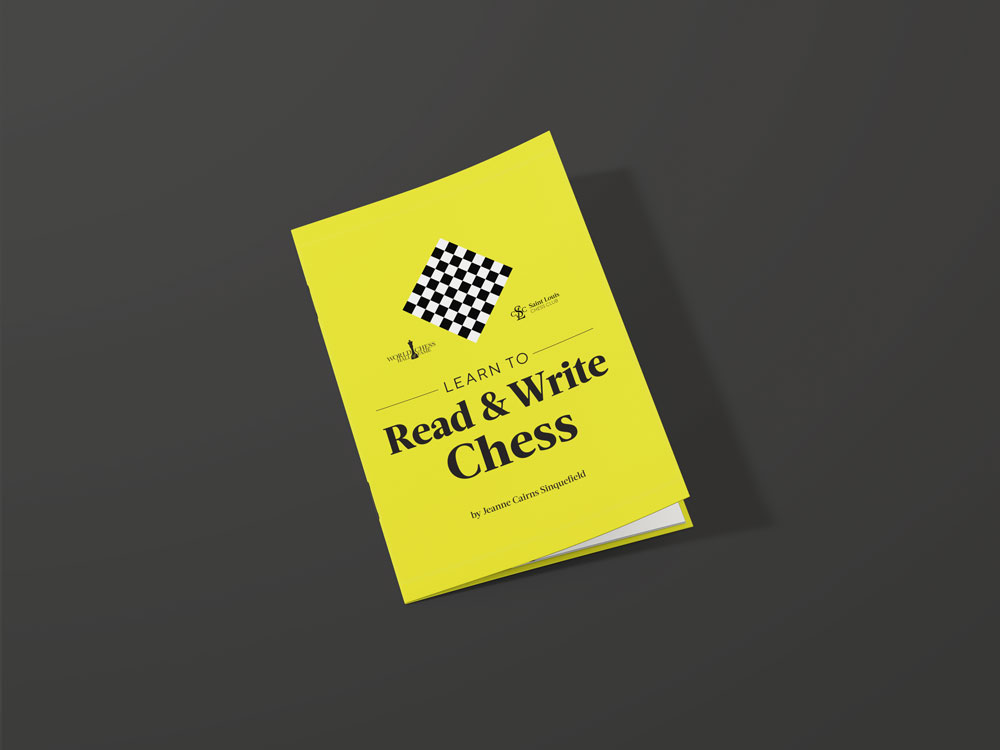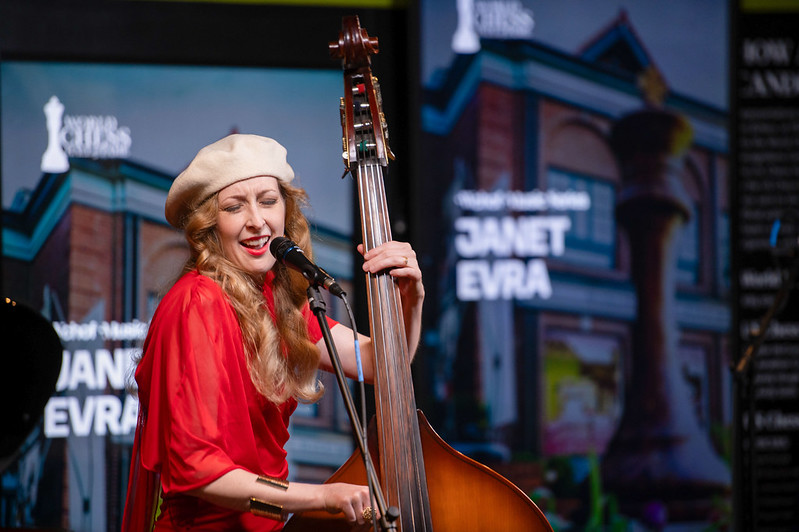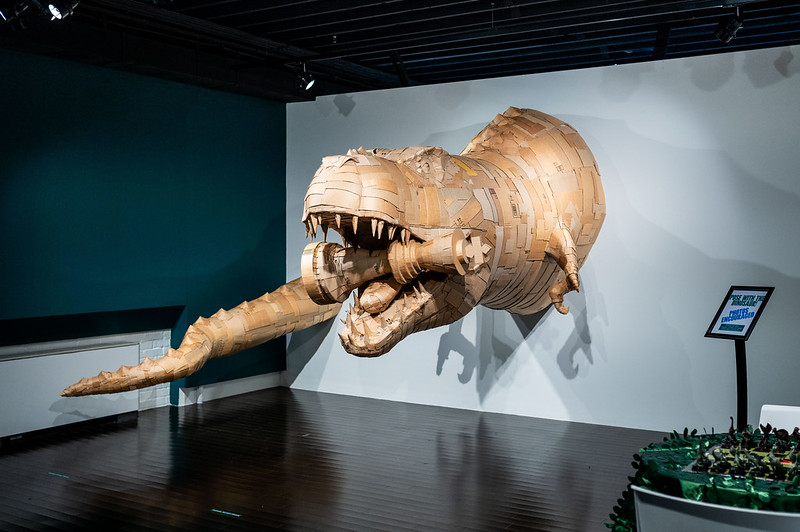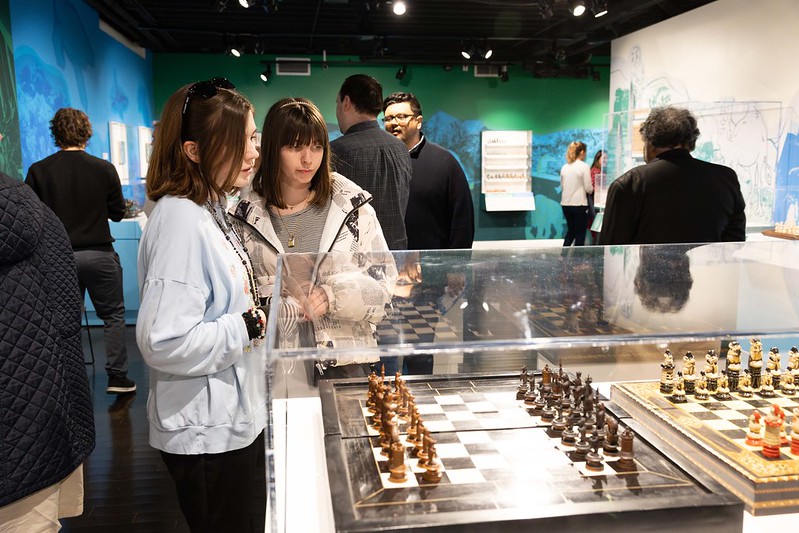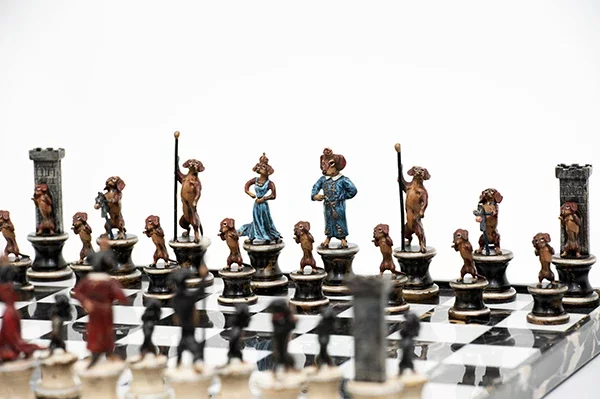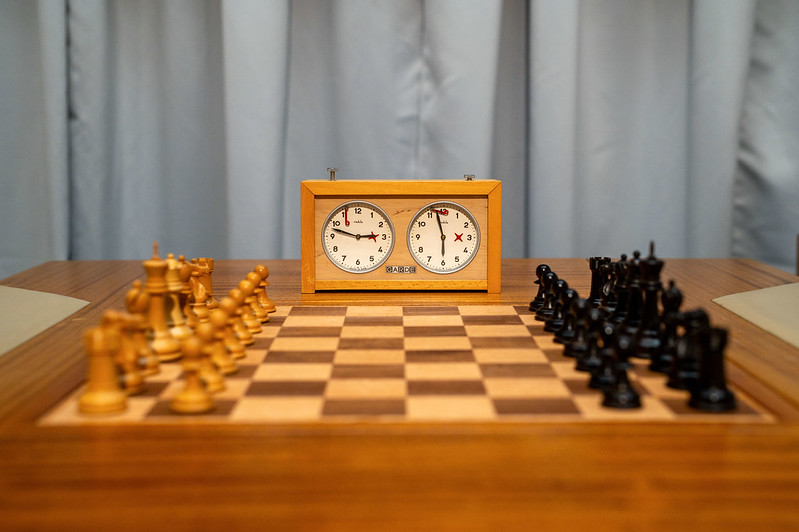June 25, 2015 - January 17, 2016
Battle on the Board: Chess during World War II
Though chess is often perceived as a game of war, it also serves as a means of passing long hours or as an aid in recuperation for members of the military. Battle on the Board: Chess during World War II provides insight into how a game modeled upon battle can provide a sense of home and community as well as demonstrating the dramatic changes the war brought to the game.
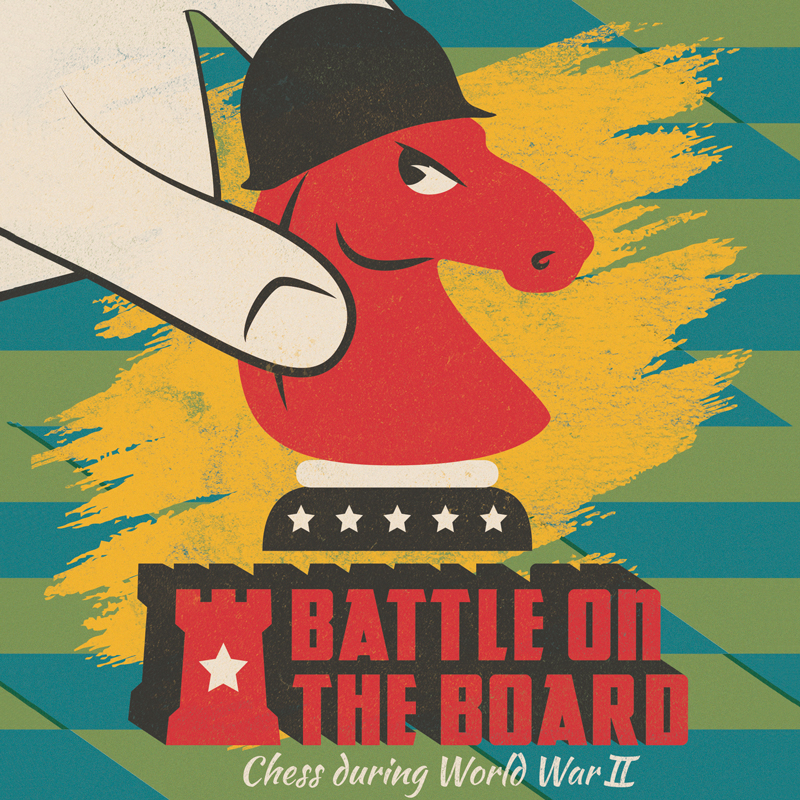
Exhibit Overview
Chess often played a part in philanthropic efforts that aimed to assist members of the military, whether in the United States, on the front, held in prisoner of war camps, or convalescing in hospitals. Chess played just one role in the larger aid efforts undertaken by American citizens, who according to a 1946 report of the President’s War Relief Committee, would ultimately donate over $1 billion to war charities between 1939 and 1945.
In 1929, the Geneva Convention Relative to the Treatment of Prisoners of War established new regulations that aimed to ensure humane treatment of prisoners of war. These included rules about camp conditions, the rights of prisoners, and medical treatment. Among these articles was a stipulation that when possible, “belligerents shall encourage intellectual diversions and sports organized by POWs.”
The International Committee of the Red Cross acted to enforce these regulations by inspecting POW camps to evaluate adherence to these standards, keeping records of the locations of POWs, and facilitating the exchange of letters and packages between POWs and their families. In an August 7, 1940, New York Times article, the Red Cross announced that relatives of POWs in European camps could send packages to them free of charge. Concerned not only with the physical well being of captured troops, but also their mental and emotional needs, the Red Cross’ original list of items that could be sent to POWs of European Axis powers included food, clothing, and toiletries as well as recreational items like books, footballs, playing cards, and chess and checkers sets. In 1942, the list of materials that could be mailed was greatly expanded, with baseball and softball equipment added to the list of permitted sporting goods.
Like other games and sports in POW camps, chess proved a means of fighting boredom and depression and provided a distraction from the fear and monotony of prison life. In November 1942, the New York Times reported that First Lady Eleanor Roosevelt visited St. James’s Palace, where the Red Cross’ Prisoner of War Department assembled parcels for captive troops. Upon learning that the favorite gifts of British POWs were chess and mahjong sets, she purchased a number of packages to send to them. In some camps, POWs organized their own chess tournaments as a means of passing time. At Stalag IIIB, the June 25, 1943, issue of the camp’s newsletter, titled POW-WOW, advertised a chess and checker tournament as a means of staving off becoming “Stalag-happy.” While captive at Stalag Luft I, 1st Lt. Harold L. Weachter, a navigator in the U.S. Army Air Forces, carved his own chess set. He even composed a poem about the experience, lamenting that after spending so much time and care in creating the set, the Red Cross sent Christmas care parcels with numerous sets.
Efforts to aid in recreation for troops also extended to camps in the United States and the European and Pacific Theaters. In 1941, the United Services Organization (USO) was formed in response to a call by President Franklin D. Roosevelt. The USO coordinated the recreation and aid efforts of six organizations: the Jewish Welfare Board, National Catholic Community Service, the National Travelers Aid Association, Salvation Army, Young Men’s Christian Association (YMCA), and Young Women’s Christian Association (YWCA). As part of their aid work, many of these organizations made gift kits for outgoing soldiers and those in hospitals, some of which included simple pocket chess sets stamped with the groups’ names.
Philanthropic efforts to create connections with civilian life were complemented by the activities of corporations of the era. The Drueke Company, a renowned American manufacturer of games, began production of pocket games, including chess. These could easily be shipped to soldiers due to their small sizes. The Coca-Cola Company donated game sets to military camps in addition to their shipment of ten complete bottling plants to the European Theater.
Unlike many federations in occupied territories abroad, the United States Chess Federation (USCF) was able to continue to conduct national chess championships through the course of the war. However, many of the nation’s top chess talents also chose to turn energies to aid efforts on the home front. Observing that the Red Cross provided chess sets at its recreation halls and hospitals and that members of many individual chess clubs across the country had initiated efforts to play chess with veterans in hospitals, the USCF partnered with the periodical Chess Review to found the organization Chess for the Wounded in 1945. They aimed to unite these disparate efforts through a national organization with five sections reflecting the regional structure of the Red Cross. Future U.S. Women’s Chess Champion Mary Bain was the Southeast’s Area Director, and the group’s board included future 1992 U.S. Chess Hall of Fame inductees Arnold Denker and Gisela Gresser. The activities of the new organization were reported in chess periodicals of the time as well as the USCF’s annual yearbook.
The May 1945 issue of Chess Review announced the new organization with an article illustrating how the game assisted wounded veterans in their recovery. During the war, it had reported stories about chess tournaments organized by members of the military and chess-related aid efforts. Though many players assisted in the project, Gisela Gresser’s work earned the attention of both the chess periodicals and national press. Gresser used her talents as the 1944 U.S. Women’s Chess Champion to organize simultaneous exhibitions for the benefit of the Red Cross and the American Society for Russian Relief, Inc., which provided humanitarian aid to Soviet citizens affected by the war. She also taught chess in hospitals through the Red Cross and in the hall of the National Maritime Union as a volunteer for the United Seamen’s Service.
While some aid efforts ended with the September 1945 conclusion of the war, many others that focused upon assisting wounded veterans and war refugees continued. Chess for the Wounded sustained its work through at least 1948, and some of its volunteers maintained or renewed their efforts after the outbreak of the Korean War. Their endeavors showed the human side of a game often associated with pure logic or competition, revealing how it could be used as a comfort in difficult times.
—Emily Allred, Assistant Curator
World War II and the Rise of Soviet Chess
Few events have impacted the chess world as dramatically as World War II. The years 1939 to 1945 witnessed a substantial decline in the number of important competitions, including the World Chess Championship and Chess Olympiad, both of which were suspended. Many prominent players were killed, while others were forced to flee their homelands and settle elsewhere, profoundly altering the balance of chess strength around the world. Although the general public often views chess as a “war game,” its practitioners are rarely seen as real life warriors. However, during World War II, chess players served with honor and distinction in a variety of roles, from combat soldiers to intelligence officers. Others took prominent roles in relief efforts. The losses of talented players as well as the immigration of European players and cultivation of talent in the Soviet Union contributed to a vastly changed landscape after the war, when the U.S.S.R. rose to prominence in international competitions and newly arrived immigrants invigorated chess in the Americas.
The chess world felt the effects of the war soon after its outbreak. The 1939 Chess Olympiad and the Women’s World Chess Championship in Buenos Aires began on August 24, 1939, and the finals commenced on September 1, the day World War II started. The English team, which included Conel Hugh O’Donel Alexander, Harry Golombek, and Stuart Milner-Barry, immediately withdrew from the event and headed home. These three went on to play critical roles in breaking the German “Enigma” code, one of the key events that led to the Nazis’ defeat.
Many other players in the 1939 Buenos Aires competitions, especially those of Jewish origin, chose not to return to Europe. This included the entire German team, Miguel Najdorf of Poland, and Gideon Ståhlberg of Sweden, among others. Soon Buenos Aires was bustling with chess activity, which continued throughout the war. New arrivals Najdorf and Erich Eliskases led Argentina to a golden period during the 1950s and early 1960s, when they won five team medals in Olympiads.
While chess in Argentina thrived, Poland suffered tragic losses. Najdorf and the other Jewish members of the Polish Olympiad team avoided the fates of many of their compatriots whom the Germans killed. The noted master problemist, organizer, and sponsor Dawid Przepiórka was executed by the Nazis, who also destroyed his magnificient and irreplaceable library. Nazi bombing raids also obliterated the British National Chess Centre in London including the valuable records housed within.
Though the wartime deaths from natural causes of dominant late 19th- and early 20th-century players José Raúl Capablanca, Emanuel Lasker, and Frank Marshall represented the end of an era, other players died tragically early. Vera Menchik, the first official Women’s World Chess Champion, was killed along with her sister and mother in a V-1 rocket bombing raid, which destroyed their South London home in the summer of 1944. Her death was a terrible blow to the developing field of women’s chess.
The World Chess Championship also changed as a result of the war. The great 1938 AVRO tournament, won by Paul Keres on tiebreak, was supposed to produce a challenger to play a title match with World Chess Champion Alexander Alekhine, however an Alekhine-Keres match never materialized. A naturalized Frenchmen living in Paris with his American-born wife, Alekhine found himself in a difficult situation during the war, and the Nazis used him for propaganda purposes. His 1946 death in Portugal transformed the World Championship from a private affair with conditions set by the reigning champion to an event organized by the World Chess Federation (Fédération Internationale des Échecs or FIDE). Due to the deaths of Alekhine and Menchik, the first World and Women’s World Chess Championships held after the war did not include reigning world champions, allowing for the achievements of a new group of players who had honed their skills in the Soviet Union during the duration of the war.
During World War II, authorities in the Soviet Union considered chess to be a morale booster and consequently organized important tournaments even after the June 1941 German invasion of their homeland. These included Kuibyshev (Samara) 1942, Sverdlovsk (Yekaterinburg) 1943, and the 13th and 14th U.S.S.R. Championships. The Soviet masters’ constant practice served them well during a radio match against the United States in early September of 1945, the first important competition held after the war. The match result stunned the chess world as the Americans, who had dominated the 1930s Chess Olympiads but played little serious chess during the war, were crushed by their Soviet counterparts, 15 ½ – 4 ½. This was the beginning of a changing of the guard. Botvinnik would soon become world champion (1948), starting a reign of Soviet champions that would continue until 1972. Soviet Olympiad teams won every Olympiad they in which they competed from 1952 to 1990, except Buenos Aires 1978.
Nevertheless, the U.S.S.R. experienced difficulties due to its huge losses of life during World War II, especially among males in their late teens and early twenties. The low number of boys born during and immediately after the war effected the development of junior talent, and there was a huge gap between Boris Spassky winning the World Junior Championship in 1955, and Anatoly Karpov taking the title in 1969. Soviet representatives in the World Student Team Championship also struggled during this period.
American players faced a formidable challenge after the war—how to compete as amateurs against the professional players of the Soviet Union and Eastern Europe. Nevertheless, like Argentina, the United States experienced a major influx of new talent due to the war, including future U.S. Women’s Chess Champion Nancy Roos from Belgium. Particularly significant was the large number of Latvians who immigrated to the United States after their country was taken over by the Soviet Union. Edmar Mednis and Charles Kalme were the most significant names but Alexander Liepnieks, Viktors Pupols, Erik and Andrew Karklins, Valdemars Zemitis, and Elmars Zemgalis also contributed greatly to American chess, often in areas of the country that previously had little chess activity.
This rise of Soviet chess after World War II had a tremendous impact on the chess world as the U.S.S.R. would dominate individual and team competitions for most of the next half century. The only 20th-century event to eclipse the impact of World War II on the game was the collapse of the Soviet empire in 1991.
—IM John Donaldson, 2015
Artifacts Featured In the Exhibition

Chess Review Vol. 12, No. 1
January 1944
8 1⁄4 x 11 in.
Periodical
Collection of the World Chess Hall of Fame, Gift of John Donaldson
The photograph on the cover of this issue of Chess Review illustrates the stakes of World War II using toys sold by F.A.O. Schwarz. The photograph includes leaders of the Allied powers: Joseph Stalin of the Soviet Union, Franklin D. Roosevelt of the United States, and Winston Churchill of the United Kingdom, along with soldiers in a variety of poses. A chessboard appears before a map of Europe, connecting the struggle to hold or conquer territory with the action of a game of chess. Chess Review was an American chess publication that included analysis and writings by top players. During the 1940s and 1950s, Chess Review distinguished itself from other chess publications by including photographs of the top players of the day.
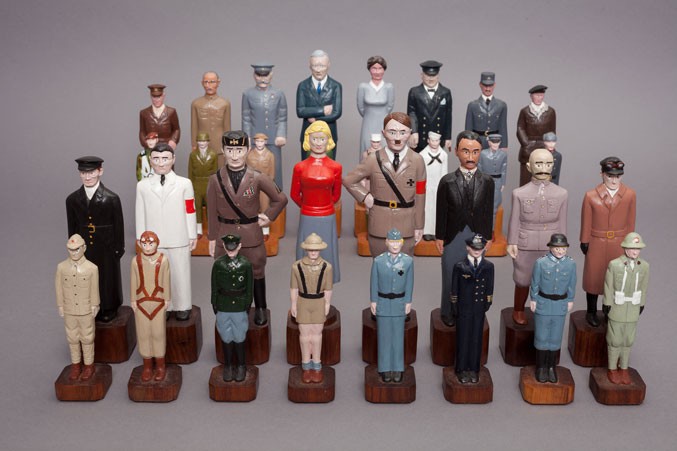
David Warther Stevens
World War II Themed Chess Set, Late 20th century
King size: 8 in.
Chess set
Collection of Dr. George and Vivian Dean
In this chess set, the leaders of the Allied and Axis powers, supported by members of their militaries, meet over the board. Dr. George Dean, a noted collector of chess sets whose pieces have been exhibited at the World Chess Hall of Fame, commissioned the set from artist David Warther Stevens.
Allied Powers
King: President Franklin D. Roosevelt
Queen: First Lady Eleanor Roosevelt
Bishops: Soviet Premier Joseph Stalin and Prime Minister Winston Churchill
Knights: Charles de Gaulle, leader of the Free French Forces, and Generalissimo Chiang Kai-Shek
Rooks: General Dwight D. Eisenhower and Field Marshall Bernard Montgomery
Axis Powers
King: Adolf Hitler
Queen: Eva Braun
Bishops: Benito Mussolini and Emperor Hirohito
Knights: General Hideki Tojo and Hermann Goering
Rooks: Field Marshall Erwin Rommel and Admiral Karl Dönitz

Chess Review, Vol. 11, No. 7
August – September 1943
10 x 7 in.
Periodical
Collection of the World Chess Hall of Fame
Both the editors of Chess Review and the leaders of the newly-formed United States Chess Federation (USCF) used military chess clubs and aid efforts aimed at injured veterans to promote the game. Here, Chess Review illustrated readers’ accounts of starting their own chess clubs. One of these includes Olaf Ulvestad, who enlisted in 1941. After the war’s end, he would participate in the 1946 U.S.A.-U.S.S.R. team match as well as numerous U.S. Open Chess Championships and U.S. Chess Championships.
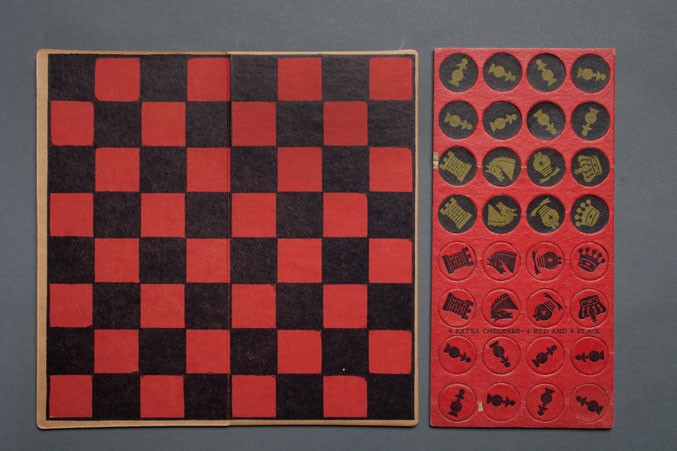
The American Red Cross Chess, Checkers, and TIC-TAC-TOE Pocket Set, c. 1944
Board (unfolded): 8 x 8 in.
Game pieces: 3⁄4 in. diameter
Game Set
Collection of the World Chess Hall of Fame, Gift of Margaret Martin
During World War II, the Red Cross assisted prisoners of war (POWs) by checking the conditions of camps, sending aid parcels, and facilitating mail between POWs and their families. The Red Cross also provided compact and lightweight pocket sets like this for entertainment. This one was owned by Staff Sergeant Arthur D. Williams, whose Boeing B-17 Flying Fortress was shot down on October 5, 1944. After being captured by German forces, Williams was taken to Stalag Luft IV, a POW camp in what is now Poland, which became infamous for its poor conditions, harsh treatment of prisoners, and an 86-day forced march after Soviet forces approached the position of the camp in 1945. At the beginning of the march, soldiers subsisted on the contents of the remaining Red Cross parcels at the camp, which they carried with them. Williams survived the war along with the set, and his daughter later donated it to the World Chess Hall of Fame.
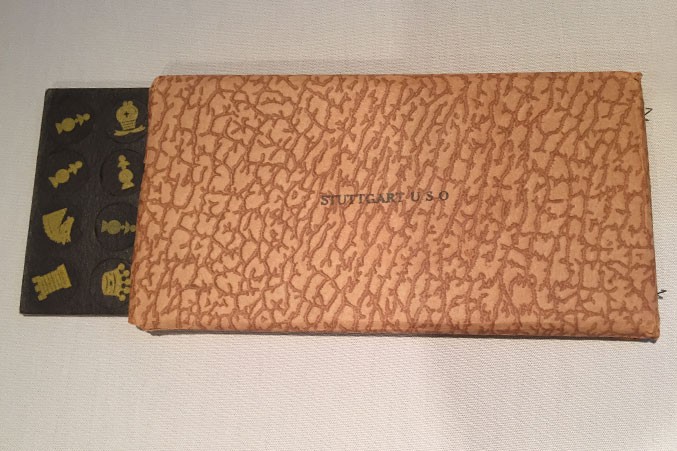
The Stuttgart USO Chess, Checkers, and TIC-TAC-TOE Pocket Set, c. 1940-1944
Board (unfolded): 8 x 8 in.
Game pieces: 3⁄4 in. diameter
Game set
Collection of the World Chess Hall of Fame
In 1941, the United Services Organization (USO) was formed in response to to a call by President Franklin D. Roosevelt. The USO coordinated the recreation and aid efforts of six organizations: the Jewish Welfare Board, National Catholic Community Service, the National Travelers Aid Association, Salvation Army, Young Men’s Christian Association (YMCA), and Young Women’s Christian Association (YWCA). As part of their aid work, some of these organizations made gift kits for outgoing soldiers and ones in hospitals, some of which included simple pocket chess sets stamped with the groups’ names.
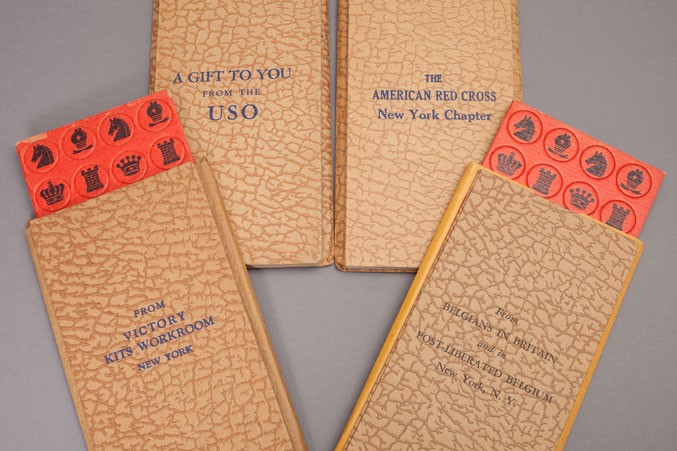
The Victory Kits Workroom Chess, Checkers, and TIC-TAC-TOE Pocket Set, c. 1940-1944
Board (unfolded): 8 x 8 in.
Game pieces: 3⁄4 in. diameter
Game set
Collection of the World Chess Hall of Fame
The USO Maneuvers Service Chess, Checkers, and TIC-TAC-TOE Pocket Set, c. 1940-1944
Board (unfolded): 8 x 8 in.
Game pieces: 3⁄4 in. diameter
Game set
Collection of the World Chess Hall of Fame
For civilians in the United States, recreation and entertainment work on the home front were important means of raising morale. The Women’s Division of the Jewish Welfare Board, one of the six organizations that founded the United Services Organization (USO), worked with Victory Kits Workroom to send parcels full of supplies and games to soldiers departing for the front and those in American hospitals. In 1943, they reported having assembled and distributed over 16,000 of these kits from their base at the Hotel Savoy Plaza in New York City.
In 1941, the United Services Organization (USO) was formed in response to a call by President Franklin D. Roosevelt. The USO coordinated the recreation and aid efforts of six organizations: the Jewish Welfare Board, National Catholic Community Service, the National Travelers Aid Association, Salvation Army, Young Men’s Christian Association (YMCA), and Young Women’s Christian Association (YWCA). As part of their aid work, some of these organizations made gift kits for outgoing soldiers and ones in hospitals, some of which included simple pocket chess sets stamped with the groups’ names.
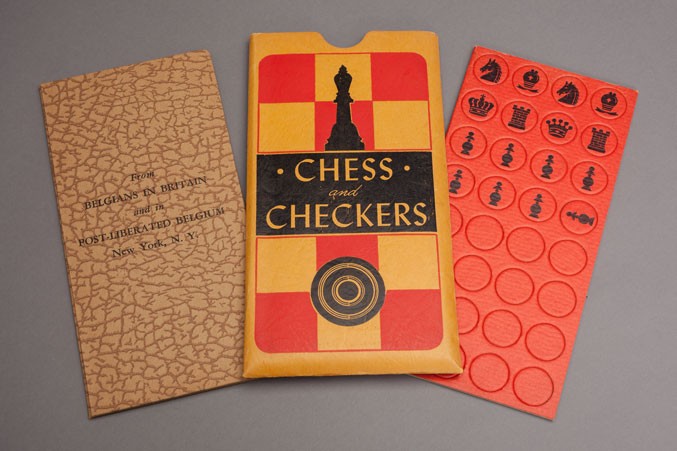
The Belgians in Britain and in Post-Liberated Belgium Chess, Checkers, and TIC-TAC-TOE Pocket Set, c 1940-1944
Board (unfolded): 8 x 8 in.
Game pieces: 3⁄4 in. diameter
Game set
Collection of Bernice and Floyd Sarisohn
Formed in October 1942, The Belgians in Britain and in Post-Liberated Belgium aimed to assist Belgians suffering from warfare in their home country as well as those who fled the country as refugees.

“He’s Home for a Moment” White Motor Company Red Cross Ad
1945
10 1⁄4 x 13 in.
Advertisement
Collection of the World Chess Hall of Fame
Stating “The most we can do is the least we can do,” this advertisement highlights the patriotic sentiment that fueled home front aid efforts for prisoners of war. Picturing grateful soldiers opening Red Cross aid parcels and ships from the Red Cross Atlantic Fleet, the ad encourages contributions for the Red Cross’ 1945 War Fund drive. The drive was accompanied by a massive publicity campaign, which included a pamphlet illustrating the work of the organization’s hospital services through a photograph of two injured soldiers playing chess.
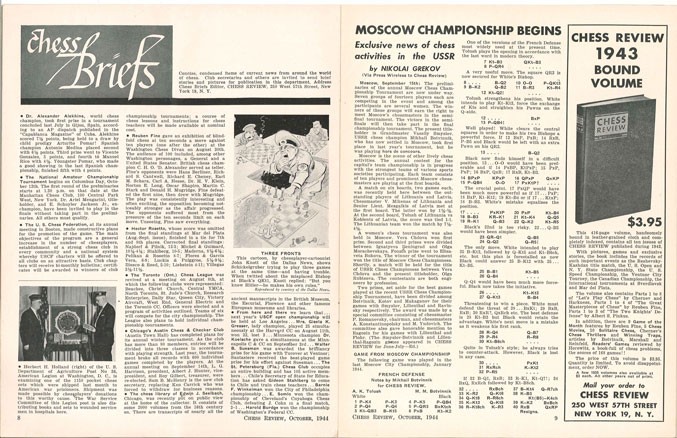
Chess Review, Vol. 12, No. 10
October 1944
8 1⁄4 x 11 in.
Periodical
Collection of the World Chess Hall of Fame
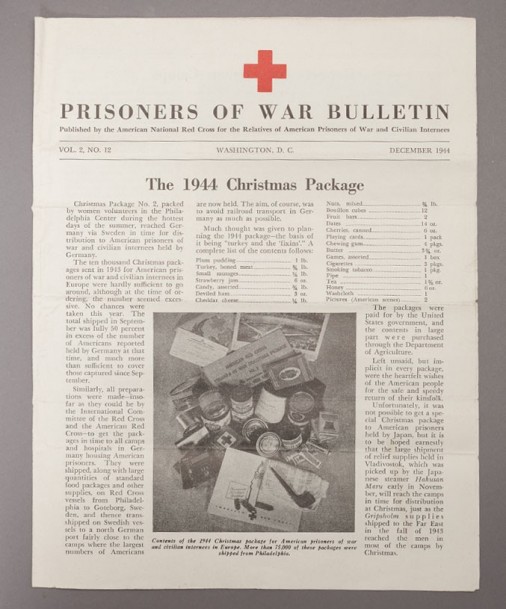
Prisoners of War Bulletin, Vol. 2, No. 12
December 1944
8 1⁄2 x 11 in.
Periodical
Collection of the World Chess Hall of Fame

Prisoners of War Bulletin, Vol. 2, No. 5
May 1944
8 1⁄2 x 11 in.
Periodical
Collection of the World Chess Hall of Fame
Sent to family members of prisoners of war, the Red Cross Prisoners of War Bulletin offered news of conditions in POW camps, advice for sending supplies to family members, and information about aid efforts being initiated throughout the country. In this issue, writers highlighted the work of Herbert H. Holland, of the U.S. Department of Agriculture Post, no. 36 American Legion at Washington, D.C. Holland sought chess sets for prisoners of war and ultimately collected 1150. Later he became the director of Chess for the Wounded. His efforts on behalf of prisoners of war and injured members of the military were highlighted in chess publications like Chess Review as well as the New York Times.
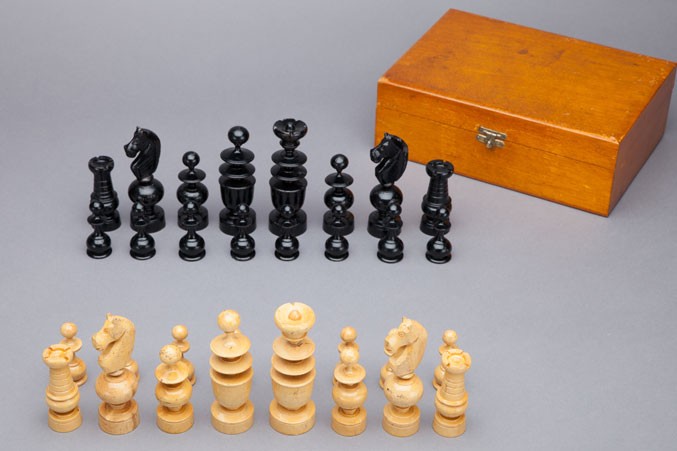
Chess Set and Box
c 1939
King size: 3 3/8 in.
Box size: 7 ¾ x 5 ½ x 2 ½ in.
Collection of Hersel J. Lillis, Sr.
A lifelong chess player, Hersel J. Lillis received this set as a gift after his 1940 enlistment in the United States army. Lillis, a native of East Saint Louis, served in both the European and Pacific Theatres. Lillis used the set as a means of passing time with other soldiers throughout the war, and he brought it with him to posts in France, New Caledonia, and Australia.

Army-issued Pocket-sized “Roll Up” Checkers Set
c 1941-1945
Board: 10 1⁄4 x 10 in.
Case (unfolded): 7 x 5 1⁄4 in.
Game pieces: 1 in. diameter
Game set
In Memory of Frank H. Braunlich Jr.
A meteorologist during the war, Lieutenant Frank Braunlich Jr. predicted weather on islands in the South Pacific during World War II. He served in the U.S. Army Air Force, and while moving from one island to another, brought along this travel checker set. Braunlich, who loved chess, more often found opponents who knew how to play checkers. When he found a fellow chess player, he would create pieces from materials at hand such as pebbles or carved wood.
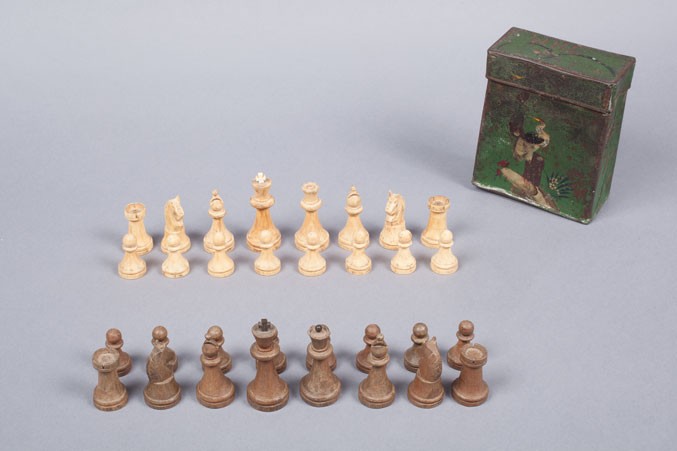
William Howard Chittenden’s Prisoner of War Chess Set and Tea Box
c 1940
King Size: 2 1⁄2 in.
Box: 5 x 4 x 2 in.
Chess set
Collection of the National Museum of the Marine Corps
Owned by three separate prisoners of war during World War II, this set tells a fascinating story of three different Marines’ experiences in prisoner-of-war camps. Japanese forces captured William Howard Chittenden, its first owner, shortly after the December 7, 1941, attack on Pearl Harbor. Chittenden, who had been serving with the Marine Detachment at the American Embassy in Peiping (Beijing), China, was then sent to Woo Sung prison camp, where civilian workers who had been captured on Wake Island were also imprisoned. At that camp he had access to Red Cross rations, which included cigarettes. Not being a smoker, Chittenden traded 20 packs for a chess set created by one of the civilian workers.
Chittenden, who would ultimately spend 1364 days in POW camps, was transferred to the Kiangwan prison camp in August 1943, where he performed forced labor. Before leaving Woo Sung prison camp, he gave his cherished chess set to a friend Vic Ciarrachi, with the hope that he could receive the set back after liberation. Unfortunately, Ciarrachi became separated from the chessmen during his own subsequent transfer to another prison camp; he packed the set and its tin in a box of garden tools that was then delivered to another camp.
At the Akahaira #2 coal camp, Platoon Sergeant Thomas R. Carpenter found the pieces and after his liberation, took them to the American cities where he was stationed. After his death, his sister first inherited the chess set and after her passing, his son Peter Carpenter inherited them. Observing that the pieces and the box bore the initials W.H.C., he embarked on an ultimately successful research project to reunite the set with its first owner. Seventy years after Chittenden and the set were separated, Peter Carpenter returned the set to him.

Indian Ivory Chess Set
c 1940s
King size: 3 1⁄2 in.
Chess Set
Collection of the World Chess Hall of Fame, Gift of Larry B. Good
Made of walrus ivory, this simple but elegant chess set was a souvenir of Stuart Canning’s travels. Canning served in the Merchant Marine, which provided critical support for the war effort during World War II by transporting troops and supplies. Canning purchased this set while in India, one of the many locations he visited as he travelled the world as part of the Merchant Marine.
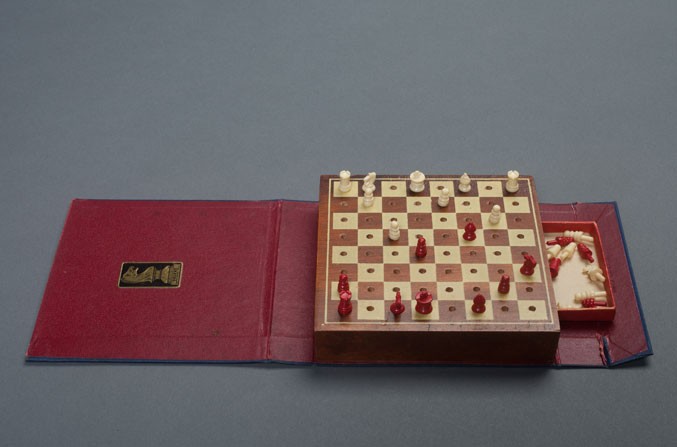
W. M. F. Drueke & Sons Pocket Chess Game
1939-1945
Chess set
Board (unfolded): 11 3⁄4 x 4 1⁄2 x 1 in.
Box: 5 x 5 x 1 in.
King size: 3⁄4 in.
Collection of the World Chess Hall of Fame
Until World War I, most Americans purchased chess sets manufactured in Europe and imported to the United States. Through his company, based in Grand Rapids, Michigan, William F. Drueke produced American chess sets to fill the need created by an interruption in the nation’s supply due to the war. During World War II, the company would go on to produce a variety of small portable game sets complete with mailing boxes, ideal for sending to soldiers.

Jeep Board by Geo. S. Carrington Co.
1943
Board: 10 1⁄2 x 3 1⁄2 x 1⁄2 in.
Game piece: 1 in.
Game Set
Private Collection
Pocket games not only served as a means of entertainment, but also created a connection with civilian life. The Jeep Board, an adaptable game and puzzle set manufactured by Geo. S. Carrington Co. was intended for use by soldiers in small spaces and included a strap for the board to tie around a soldier’s leg during play.
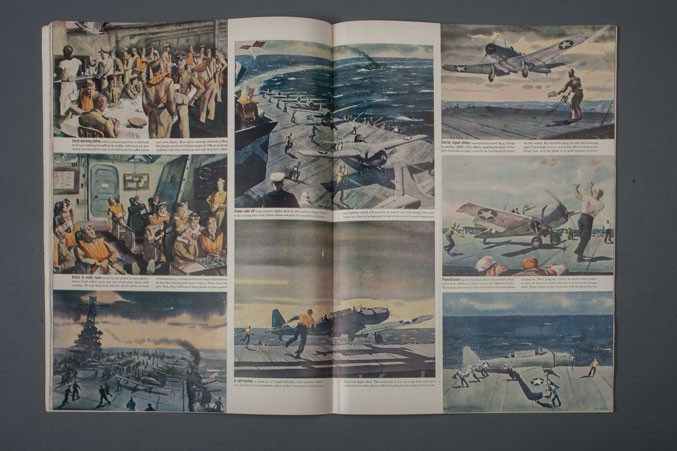
“Paul Sample’s Naval Aviation”
LIFE Magazine, January 4, 1943
10 1⁄2 x 13 1⁄2 in.
Periodical
Collection of the World Chess Hall of Fame
Regionalist artist Paul Sample illustrated scenes of everyday life on a Navy aircraft carrier for civilian audiences. Sample himself had served in the Naval reserve during World War I, and during World War II, worked as a correspondent for LIFE Magazine. From pilots awaiting action to dramatic rescues of downed pilots, Sample shared vignettes portraying the broad experiences of men at war. In this spread, one of his works portraying pilots passing time by playing chess is illustrated.
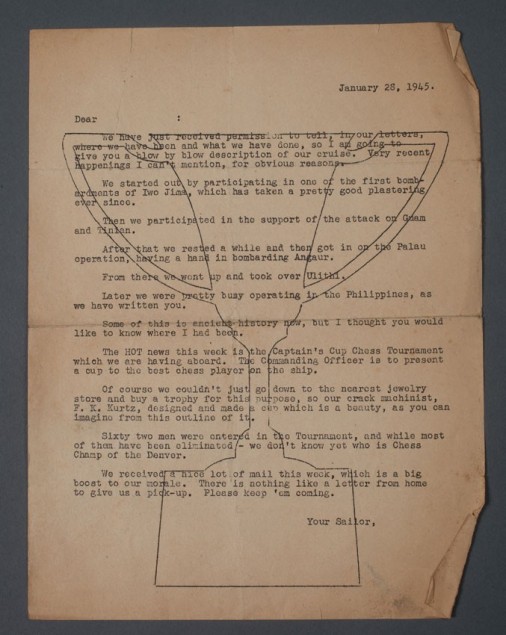
World War II Approved Form Letter
January 28, 1945
9 x 11 in.
Document
Collection of the World Chess Hall of Fame
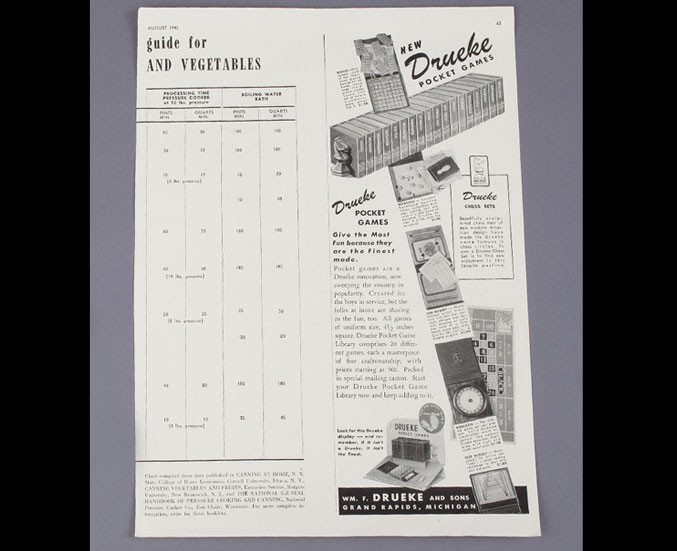
Drueke Chess Pocket Game Advertisement
1943
12 1⁄2 x 8 3⁄4 in.
Advertisement
Collection of Duncan Pohl
Advertising the Drueke Pocket Game library, this ad for William F. Drueke and Sons illustrates a wide variety of pocket games, including chess, checkers, backgammon, and even roulette. A store display for the company, illustrated at the bottom of the ad, suggests that consumers “make him [a soldier] happy” by sending him a game a month. In a July 26, 1942, article for the New York Times, a writer noted that “Miniature game sets, the kind that you can pull out of your pocket and use for chess, checkers and several other games, are having a great vogue with boys in the Army, and the vogue is carrying over to ordinary citizens.” After the war, Drueke would continue to be a top American producer of chess sets.
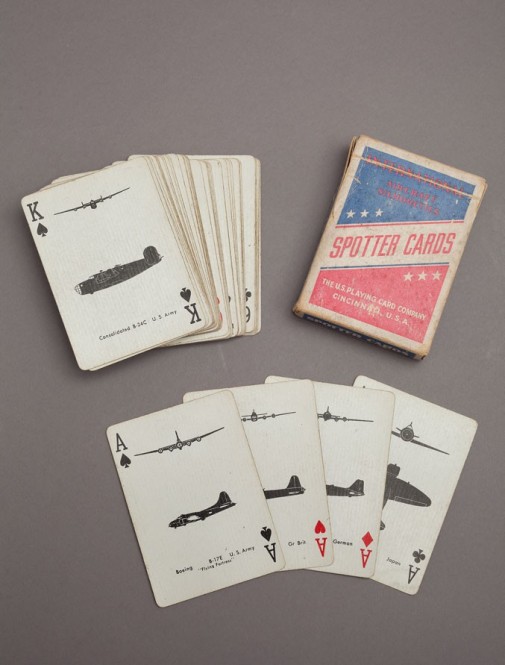
Spotter Cards
1942-1945
Cards: 3 1⁄2 x 2 1⁄2 in.
Box: 3 1⁄2 x 2 1⁄2 x 3⁄4 in.
Playing cards
Collection of the World Chess Hall of Fame
While games often served as entertainment, others, like these spotter cards, were also designed for practical purposes. Decks of cards like these, which illustrated the silhouettes of Axis and Allied aircraft, were distributed to both members of the military and volunteers on the home front assisting in civil defense efforts.
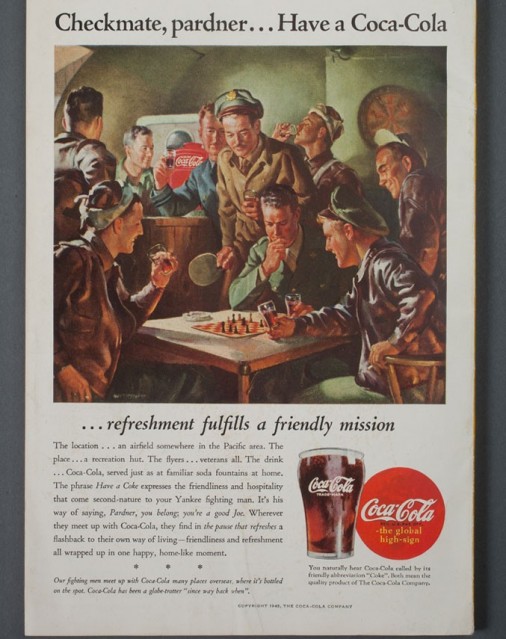
The Coca-Cola Company Advertisement in The National Geographic Magazine
August 1945
10 x 6 3⁄4 x 1⁄4 in.
Periodical
Collection of the World Chess Hall of Fame
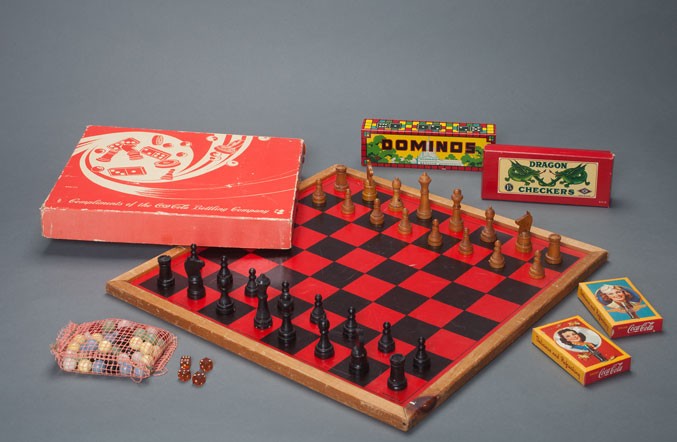
The Coca-Cola Company Game Set
c 1941-1945
Board: 16 ½ x 16 ½ in.
Box: 11 ¾ x 9 ¼ x 1 ½ in.
King size: 2 ½ in.
Game Set
Collection of the World Chess Hall of Fame
As part of an outreach program during World War II, The Coca-Cola Company shipped game sets to boost the morale of soldiers overseas. The game sets include a chess/checkers/backgammon board, chess pieces, checkers, playing cards, marbles, and dominoes. The boxes for the different game sets were designed with imagery appealing to soldiers separated from their homes and family, including the White House and beautiful young women.
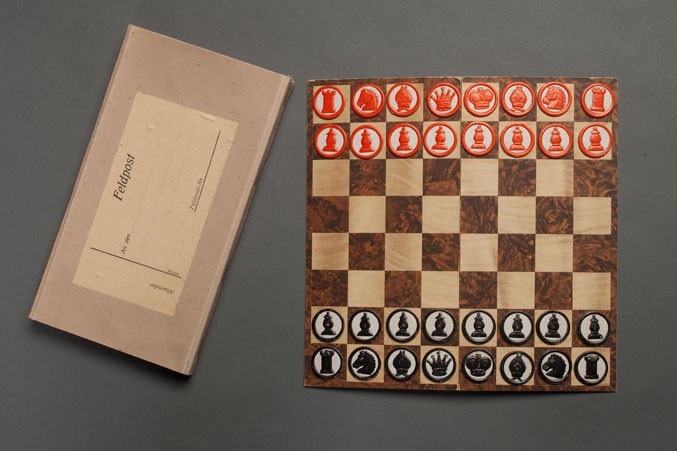
Feldpost Chess Set
c 1940
Chess set
Board (unfolded): 8 ¾ x 8 ¾ in.
Box: 9 ½ x 5 x ¾ in.
Game pieces: 1 in. diameter
Collection of the World Chess Hall of Fame
Feldpost was the name of the German military postal service during World War II. Similar to the American wartime relief efforts, Germans sent recreational games to their soldiers. The foldable board and flat pieces made of cardboard allow for easy transportation and packing of the game.

Tak-Tik Wehr-Schach
1937-1938
Board (unfolded): 15 x 15 in.
Box: 15 x 7 ½ x 2 ½ in.
King size: 1 ¾ in.
Chess set
Collection of the World Chess Hall of Fame
Tak-Tik Wehr-Schach was a German board game inspired by the game of chess. The German military, Wehrmacht, distributed the game. Unlike chess, Tak-Tik Wehr-Schach has 121 squares and 18 pieces on each side. The pieces have militant names representative of the game’s era of origin: Infanterie, Hauptfigur, Panzer-kampfwagen, Artillerie (flak), Flieger: Jagdflieger and Kampfflieger. In English, they refer to infantry, protagonist, tank, anti-aircraft artillery, and flyers: fighter pilot and combat pilot. Some of the pieces fit the literal translations, while others, such as the Hauptfigur and Jagdflieger, have been represented more symbolically: as a large predatory bird and a winged human, respectively.

Schach-Dame und Mühle
1940-1945
Board (unfolded): 9 x 9 in.
Box: 9 ½ x 5 x ½ in.
Game piece: 1 in. diameter
Chess set
Collection of the World Chess Hall of Fame
The “Schach-Dame und Mühle” game set features two German soldiers playing chess while one soldier cries out, “Schach Matt!” or “Checkmate!” To the side of the illustration, the last line of the text translates to, “A greeting from home,” indicating the German soldiers, like their American counterparts, were sent chess boards for war-time recreation. Dame and Mühle refer to the games checkers and Nine Men’s Morris or Mills.
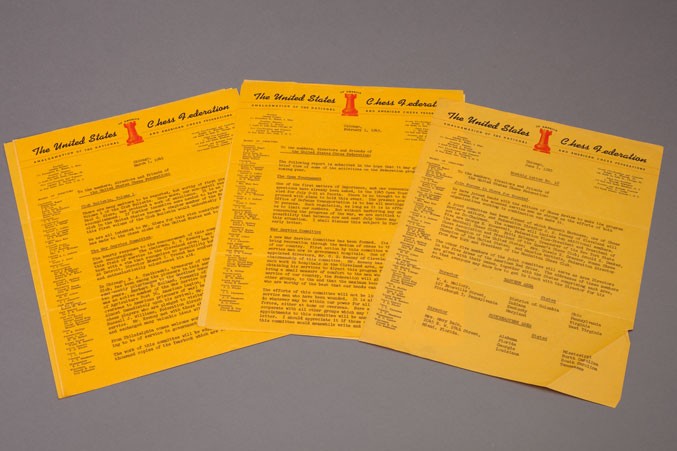
United States Chess Federation Bulletin, February 1, 1945
8 ½ x 11 in.
Document
United States Chess Federation Bulletin, March 1, 1945
8 ½ x 11 in.
Document
United States Chess Federation Bulletin, June 1, 1945
8 ½ x 11 in.
Document
John G. White Chess Collection at the Cleveland Public Library
Formed in 1939, the United States Chess Federation (USCF) mailed newsletters like these to its membership in the years before its publication Chess Life was founded. They reported important tournaments, news from around the country, and in the case of these bulletins, the efforts of one of the fledgling organization’s first philanthropic efforts. Here the USCF reports the activities of its War Service Committee, which aimed to assist injured service men. Future issues of the bulletin report the activities of the committee as well as the area directors. March’s bulletin would highlight two of the varied efforts that Chess for the Wounded would seek to unite under one umbrella: those of Bruno Czaikowski, the treasurer of the Chicago Chess and Checker Club who visited wounded veterans beginning in 1943, and Herbert Holland, who had earlier collected chess sets to send to prisoners of war.

The Yearbook of the United States Chess Federation
1945
9 x 6 x 1⁄4 in.
Periodical
Collection of John Donaldson
The United States Chess Federation (USCF) yearbook for 1945 recounts the creation of Chess for the Wounded and reports on its activities across the country. As with many other wartime aid efforts, though the co-chairmen of Chess for the Wounded were men, many of its volunteers were women. 1944 U.S. Women’s Chess Champion Gisela Gresser was a committee member, future U.S. Women’s Chess Champion Leslie Bain served as one of the group’s area directors, and future 7-time U.S. Women’s Chess Champion Mona May Karff volunteered for the group. The group also featured a training program to teach young women how to educate about the game in hospitals.
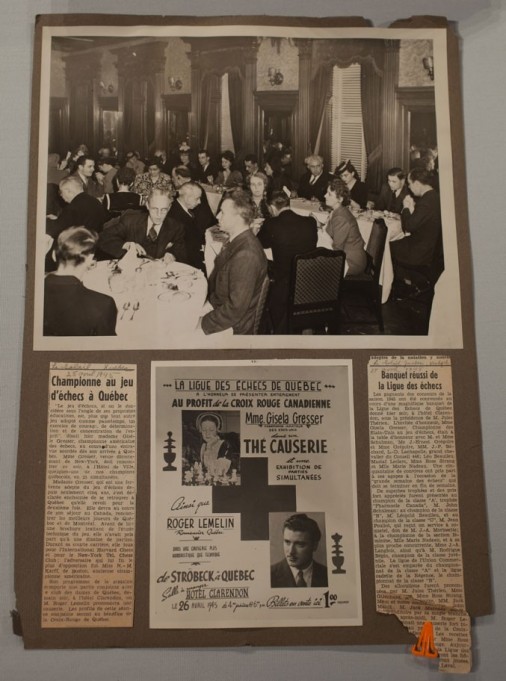
Red Cross Benefit Scrapbook Page
c 1945
15 x 10 1⁄2 in.
Document
John G. White Chess Collection at the Cleveland Public Library
Gisela Gresser kept records of her chess achievements along with her aid efforts in a scrapbook, which is now housed at the John G. White Chess Collection at the Cleveland Public Library. This page, as well as the letters on display in this case detail one simultaneous exhibition she performed for the benefit of the Red Cross during “Chess Week” in Quebec, Canada.
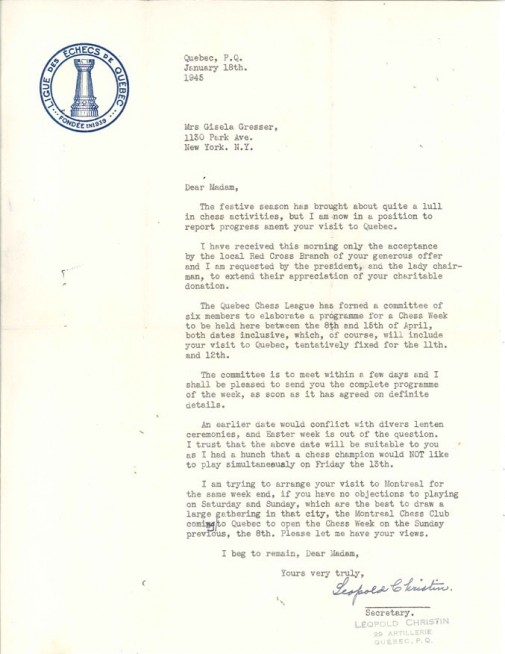
Letter from Leopold Christin to Gisela Gresser
January 18, 1945 8 ½ x 11 in.
Document
John G. White Chess Collection at the Cleveland Public Library

Letter from Leopold Christin to Gisela Gresser
November 1, 1944
8 ½ x 11 in.
Document
John G. White Chess Collection at the Cleveland Public Library

Letter to Mrs. Leslie Bain from Mrs. Elizabeth Orr
January 11, 1945
8 ½ x 11 in.
Document
John G. White Chess Collection at the Cleveland Public Library
In this letter, written in early 1945, Elizabeth Orr, the Head Recreation Worker at the Army Air Force (AAF) Regional and Convalescent Hospital, thanks Mary Bain for her assistance with aid efforts in the Miami area. The AAF Regional and Convalescent Hospital in Coral Gables, Florida, was established in the Biltmore Hotel and was one of a network of regional hospitals founded in cities near airstrips to help wounded service members who had been airlifted to the United States for care. Bain, a future U.S. Women’s Chess Champion, would later become the Director of the Southeastern region for Chess for the Wounded, an organization that aided injured veterans recovering in hospitals.
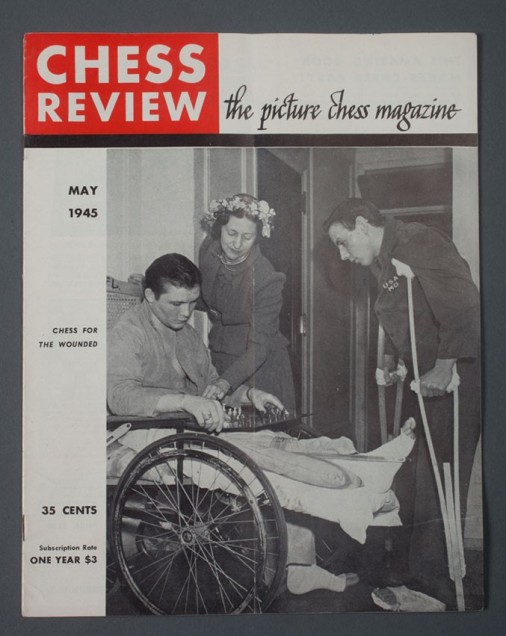
Chess Review, Vol. 13, No. 5
May 1945
8 ¼ x 11 in.
Periodical
Collection of the World Chess Hall of Fame, Gift of John Donaldson
1944 U.S. Women’s Chess Champion Gisela Gresser visited several army and naval hospitals, boosting morale of soldiers by teaching them to play chess. Here, at the Thomas M. England Hospital in Atlantic City, New Jersey, Gresser visits with Private First Class (Pfc.) Thomas Zabicki while Pfc. George Meyers, watches from behind. For injured soldiers confined to their beds, chess served as a strenuous mental game with minimal physical requirements.
This issue of Chess Review contains a detailed illustrated account of chess-based aid efforts in hospitals, including the story of Sergeant James Day. Day, a former state chess champion, lost his hand to a grenade in Europe and had sunk into depression during his recovery at the hospital but found relief through chess. It also includes the story of Lieutenant Harold Eck, who recounted learning chess in a prisoner-of-war camp before being transferred to hospital in the United States. His chess partner, Captain Joseph Brady, said that, “When you’re in the hospital, you have lots of time on your hands and chess keeps us going. I don’t know what we’d do without it,” before recounting how he and Eck played chess from their respective hospital beds by shouting the moves to each other.
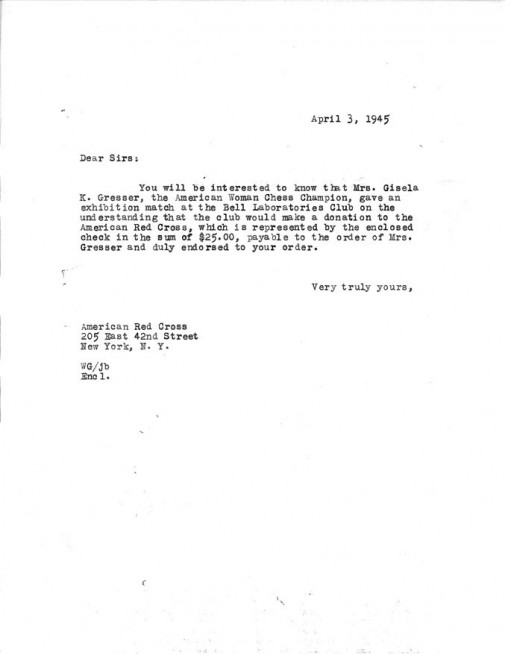
Red Cross Letter Concerning Gisela Gresser’s Relief Chess Simul
April 3, 1945
8 ½ x 11 in.
Document
John G. White Chess Collection at the Cleveland Public Library
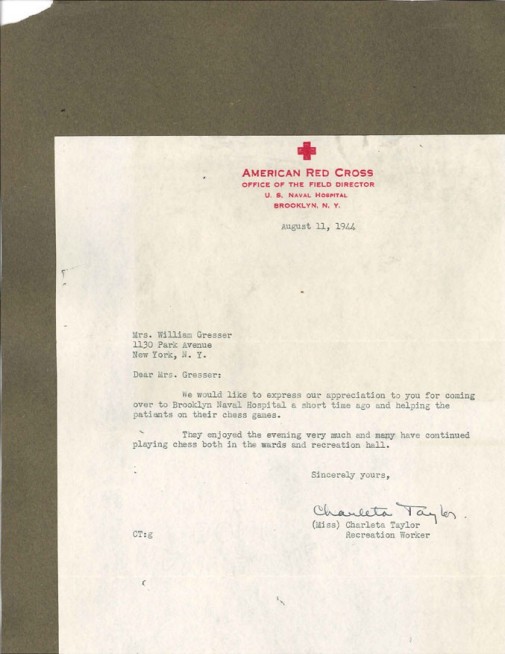
Letter from Charleta Taylor to Gisela Gresser at the American Red Cross
August 11, 1944
8 ½ x 11 in.
Document
John G. White Chess Collection at the Cleveland Public Library
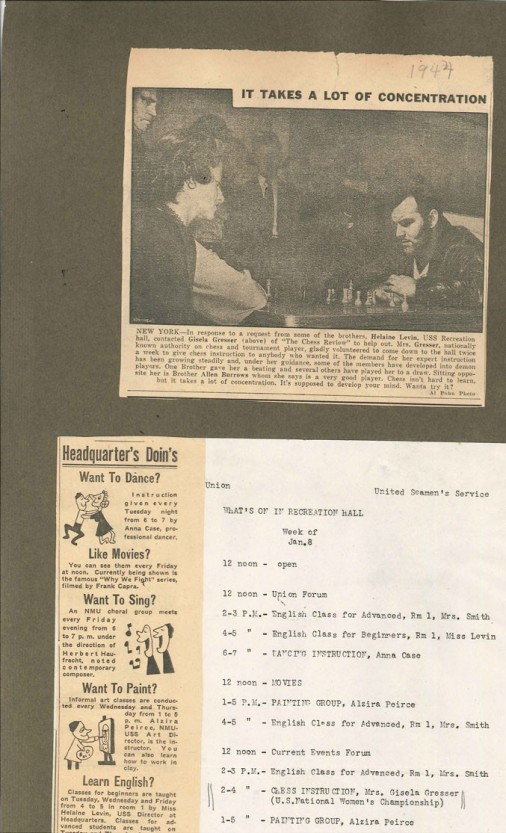
United Seamen’s Service Ephemera and National Maritime Union Scrapbook Page
c 1945
14 ¾ x 10 ¼ in.
Document
John G. White Chess Collection at the Cleveland Public Library
From Gisela Gresser’s scrapbook, this page contains newspaper articles about the recreational activities of the National Maritime Union (NMU). The newspaper clippings come from the NMU Pilot, a newspaper dedicated to local and international wartime affairs. The National Marine Union was founded by Joseph Curran, as part of his advocacy for better pay for marine workers. The documents highlight the recreational activities at the NMU. In particular, Helaine Levine organized activities for soldiers, including chess lessons by Gisela Gresser.
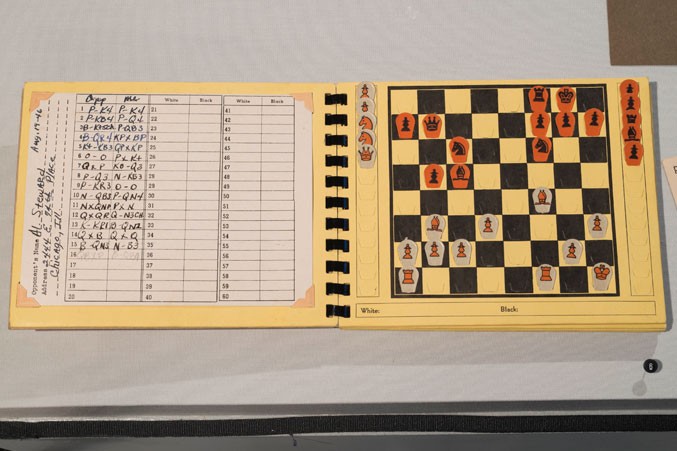
Chess for the Wounded Postal Chess Recorder
1946
Board (unfolded): 5 ¾ x 14 1 /8 in.
Postcards: 3 ¼ x 5 ½ in.
Postal recorder
Collection of the World Chess Hall of Fame
Given by the director of Chess for the Wounded, Herbert Holland, to H.H. Krueger, this postal set contains notation of each of the injured veteran’s games. Holland, who had previously worked to send chess sets to American prisoners of war, became the director of Chess for the Wounded following a move to Chicago. There, the group organized visits to hospitalized veterans by volunteers as well as the distribution of postal chess recorders. Through these artifacts, players could keep track of multiple games against multiple opponents at once, recording their moves on cards which could be removed from the recorder after the game.
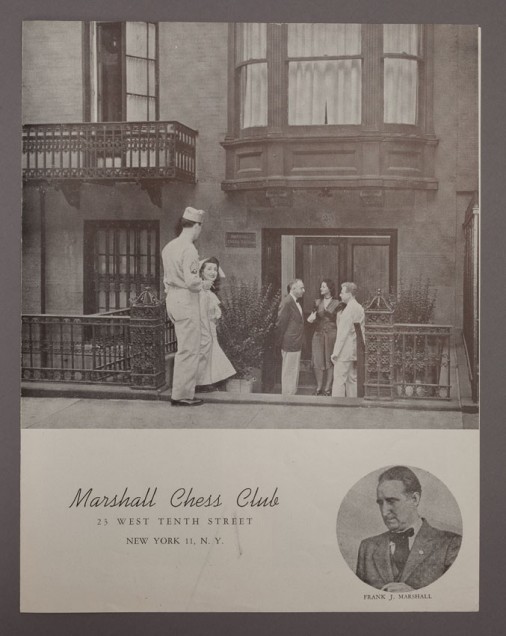
Advertisement for Marshall Chess Club
c 1940
8 x 10 ¼ in.
Periodical
John G. White Chess Collection at the Cleveland Public Library
Frank J. Marshall, a 1986 inductee to the U.S. Chess Hall of Fame and the Marshall Chess Club’s founder, played professional chess throughout the early 1900s. Sociable and outgoing, he collected a group of fellow chess players together to start Marshall’s Chess Divan in 1915. Years later, in 1931, they established the brick and mortar Marshall Chess Club. The organization remains a well-respected chess club to this day, having attracted members such as Bobby Fischer and Reuben Fine. This advertisement for the Marshall Chess Club featuring an American soldier and a nurse (perhaps the same two pictured on the cover of the Chess Review on view in this case), communicates the group’s patriotism during the war era.
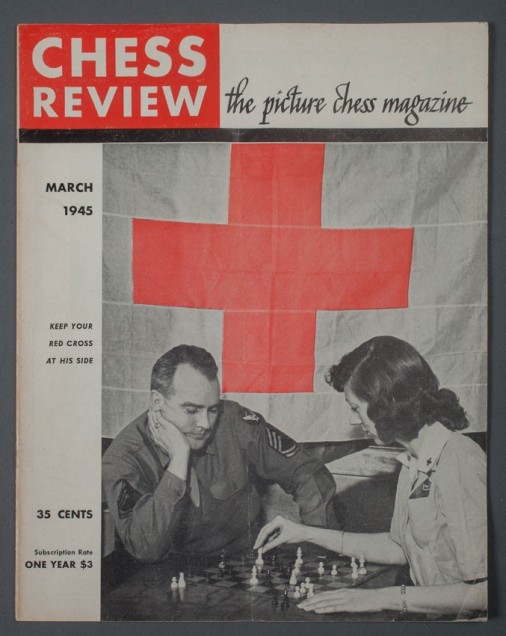
Chess Review, Vol. 13, No. 3
March 1945
8 ¼ x 11 in.
Periodical
Collection of the World Chess Hall of Fame, Gift of John Donaldson
The cover for the March 1945 edition of Chess Review features Technical Sergeant Louis Barry playing chess against Red Cross Assistant Field Director Jane C. Sickler, at the Army Air Force Convalescent Hospital in Pawling, New York. The hospital in Pawling cared for the soldiers who could perform everyday physical tasks without the assistance of a nurse. There, recreational activities and morale boosters became as much of a priority as physical rehabilitation. Activities like chess entertained the patients while they recovered enough to return to life outside the hospital.
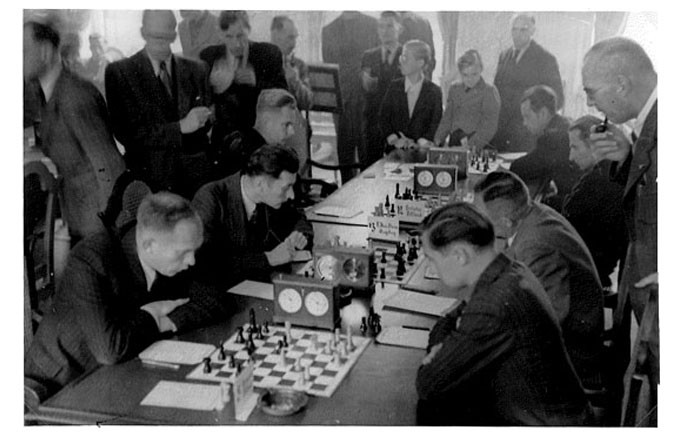
Elmars Zemgalis Playing Leonids Dreibergs
1946
5 x 7 3 /8 in.
Print, Photographic
Collection of John Donaldson
In this photograph, Elmars Zemgalis, the author of Chess Behind Barbed Wire plays in the first round of the Augsburg chess tournament. Zemgalis is nearest the viewer on the right playing with the white pieces against Leonids Dreibergs. Zemgalis, who lived in a displaced persons camp for Latvian refugees after the close of World War II, ultimately settled in Seattle, Washington, in 1952. He was part of a wave of European players who immigrated to the United States in the war and postwar years, elevating the level of chess talent in areas of the country that had not previously fostered the game.

Valentins Berzzarins and Elmars Zemgalis
Chess Behind Barbed Wire
1946
8 x 5 ½ x ¼ in.
Book
Collection of John Donaldson
Published in 1946, Chess Behind Barbed Wire recounts the experiences of Latvian refugees in displaced persons (DP) camps just after the close of World War II. In the final months of the war, many citizens of Baltic nations fled Soviet occupation of their countries, settling in DP camps in western Europe. Often the members of these camps hosted recreational activities to pass the time. This book records fifty games played by displaced persons in camps in Denmark, Germany, and Belgium.
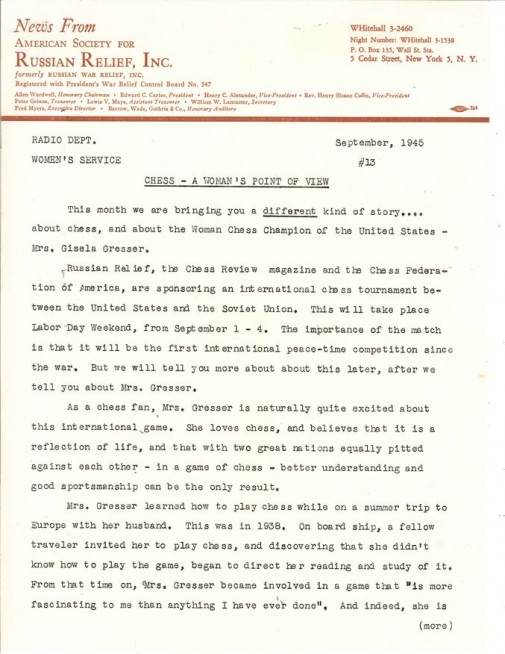
Chess–A Woman’s Point of View
September 1945
8 ½ x 11 in.
Document
John G. White Chess Collection at the Cleveland Public Library
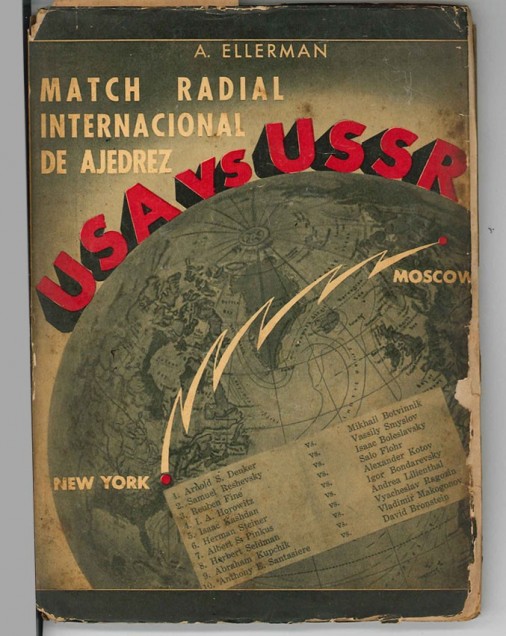
Arnoldo Ellerman
Match Radial Internacional de Ajedrez Buenos Aires: Editorial Grabo
1945 8 x 5 ½ in.
Book
Collection of the World Chess Hall of Fame
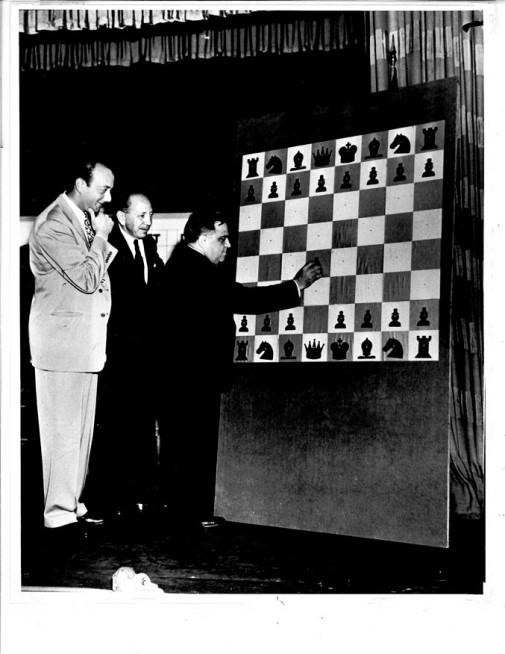
U.S.A.-U.S.S.R. Radio Match
1945
8 x 10 in.
Photograph
Collection of the World Chess Hall of Fame
Taken at the U.S.A.-U.S.S.R. Radio Match, this photograph pictures 1944 U.S. Chess Champion and American team member Arnold Denker and chess philanthropist Maurice Wertheim observing as New York Mayor Fiorello LaGuardia makes the match’s ceremonial first move. The match stoked excitement for the game throughout the country, and chess clubs nationwide followed the match as it happened. It was partially sponsored by the American Society for Russian Relief, an aid organization aimed at helping Soviet citizens suffering due to the Nazi invasion of their homeland during World War II. U.S. Women’s Chess Champion Gisela Gresser performed a simultaneous exhibition in conjunction with the radio match that benefited the organization.
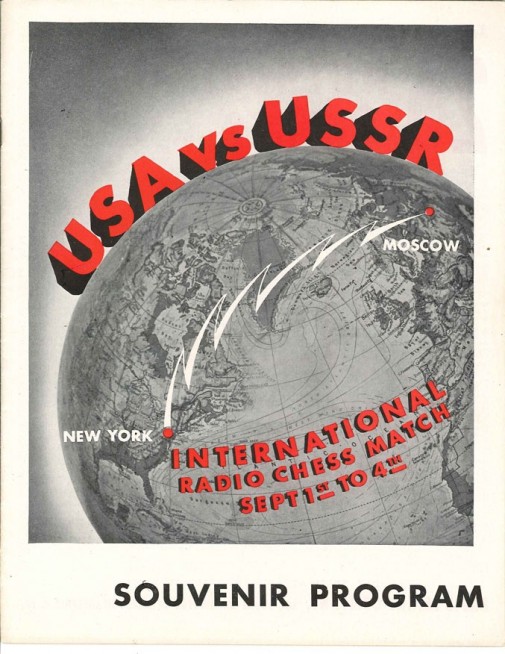
U.S.A. vs U.S.S.R. International Radio Chess Match Souvenir Program
1945 8 ½ x 11 in.
Pamphlet
Collection of John Donaldson
The first major competition held after World War II, the U.S.A. vs. U.S.S.R. International Radio Chess Match included some of the best players from the two countries. The American team included six future members of the U.S. Chess Hall of Fame: Arnold Denker, Reuben Fine, I.A. Horowitz, Isaac Kashdan, and Abraham Kupchik, while the Soviet team included two future World Chess Hall of Fame inductees, Mikhail Botvinnik and Vasily Smyslov. While chess continued in both nations during the war, the Soviet government put a special focus on developing the skills of its top talents, viewing the country’s mastery of chess as a point of pride. The Soviets’ wartime tournament experience paid off, and they won the world’s first radio chess match 15 ½-4 ½.
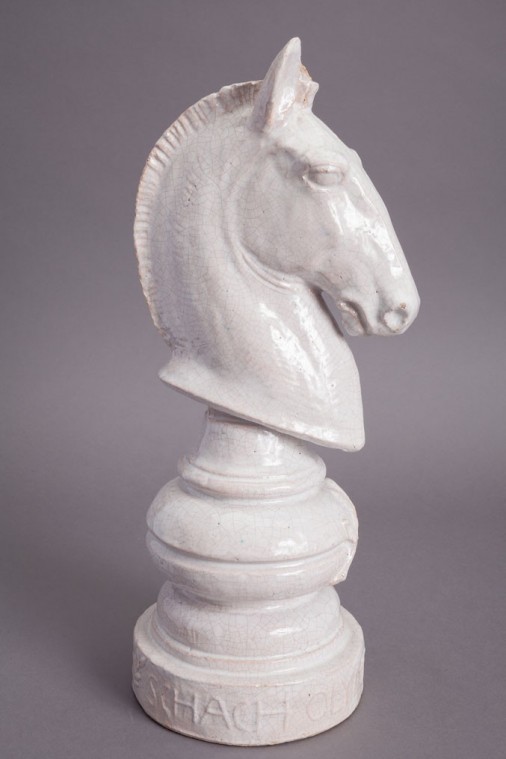
1936 Munich Unofficial Chess Olympiad Sculpture
1936
15 ½ in. tall x 5 ¾ in. diameter
Sculpture
Collection of the World Chess Hall of Fame
This sculpture depicting a knight was created for the 1936 Munich Chess Olympiad, which was considered unofficial due to the German Chess Federation’s expulsion from the International Chess Federation (Fédération Internationale des Échecs or FIDE). The German Chess Federation’s anti-semitic policies banning participation of Jewish players in its activities led to this policy. For the 1936 competition, the German Chess Federation reversed this rule, and FIDE allowed individual players and countries to decide if they wanted to take part in the competition. At the urging of the president of the Polish Chess Federation, Miguel Najdorf, one of Poland’s top players, chose to participate despite his reticence to play in a competition run by Nazi powers, ultimately winning a gold medal on the second board.

“Chess Stars Vie for USSR Title”
Chess Review, Vol. 12, No. 2
February 1944
8 ¼ x 11 in.
Periodical
Collection of the World Chess Hall of Fame, Gift of John Donaldson
The 13th U.S.S.R. National Chess Championship was initially scheduled to occur in 1941. However, due to the Nazi’s attack on Russia, the event was postponed for several years. Some of the original contestants for the tournament were killed or wounded in the war. This article predicts potential outcomes for the tournament based on the records of some of the bigger names in Russian chess: Mikhail Botvinnik, Vasily Smyslov, and the “Enigma” Salo Flohr. Though tournament play diminished elsewhere in the world, in the Soviet Union several strong tournaments were held over the course of the war.
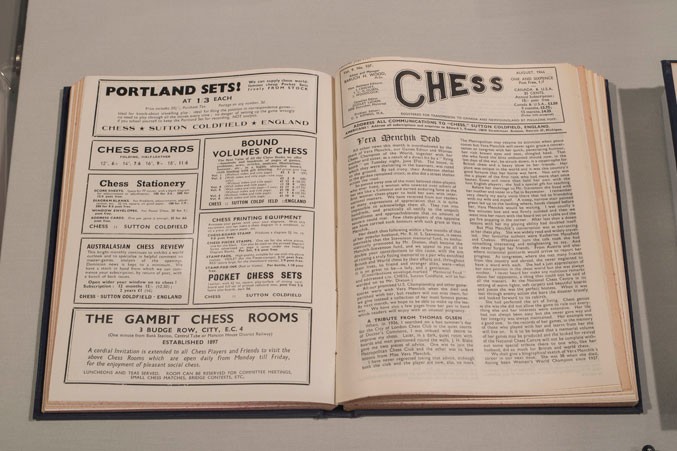
“Vera Menchik Dead”
Chess Magazine, Vol. 9, No. 107
August 1944
9 ¼ x 7 ¼ x 1 in.
Bound periodical
Collection of John Donaldson
Chess magazine, a British chess periodical, featured a full page homage to reigning Women’s World Chess Champion, Vera Menchik, after her tragic death during World War II. A German bomb hit her home, destroying the basement shelter where Menchik and her mother and sister sought protection during the air raid. A trailblazer in the world of women’s chess, Menchik’s accomplishments earned her the respect of her male contemporaries. She served as the games editor of Chess, which ran the obituary on view in this case. Thomas Olsen, a regular contributor to the publication, offered an intimate portrait of Menchik to supplement the obituary, praising her cultured background and eloquent conversation in addition to her chess skills.
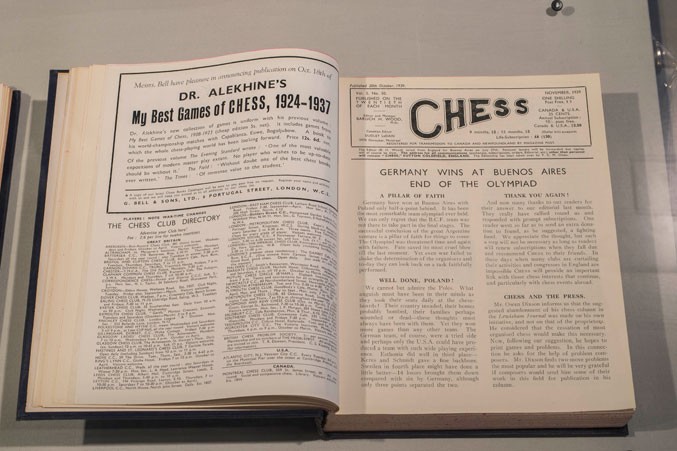
“Germany Wins at Buenos Aires End of the Olympiad”
Chess Magazine, Vol. 5, No. 50
November 1939
9 1⁄4 x 7 1⁄4 x 1 in.
Bound periodical
Collection of John Donaldson
During the 1939 Buenos Aires Chess Olympiad, a team chess competition hosting countries from around the world, World War II broke out. While the English team immediately withdrew from the competition so that its players could return home, other players (particularly Jewish players and the German team) chose to stay in South America to avoid persecution at the hands of the Nazis. Miguel Najdorf, who had played for Poland, remained in Argentina and tragically lost his entire family during the Holocaust.
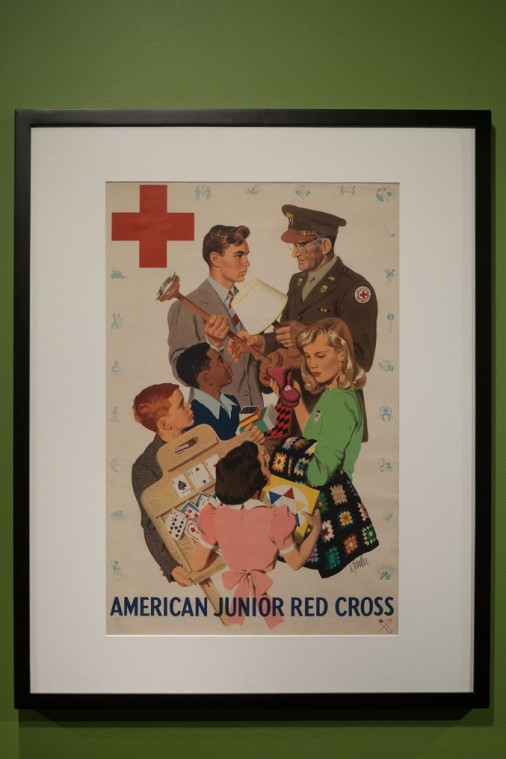
American Junior Red Cross Poster
c 1940-1945
14 1⁄2 x 22 1⁄2 in.
Poster
Collection of the World Chess Hall of Fame
Founded in 1917, the American Junior Red Cross collected comfort and recreational materials for the United States’ armed forces as well as for foreign refugees and children suffering due to the destruction of war. In 1942, members of the American Junior Red Cross in Chicago public schools constructed game sets for members of the military, which supplemented the students’ earlier efforts building splints, stretchers, and first aid equipment. Numbering over 18.5 million members by 1945, the organization allowed children the opportunity to participate in relief work on the home front. In this promotional poster, children collect aid and comfort items, including a chess and checker board.

Harold Weachter
Prisoner of War Chess Set
c 1944
King size: 2 1/2 in.
Chess Set
Collection of the National Museum of the United States Air Force

Scrapbook
Image courtesy of National Museum of the United States Air Force
During the 22 months that he was held captive at Stalag Luft I, a prisoner-of-war camp near Barth, Germany, First Lieutenant Harold Weachter carved this chess set as a means of passing time. Weachter served in the U.S. Army Air Forces as a navigator for the 100th Bombing Group and was captured in 1943. Weachter wrote a humorous poem about the creation of the set, detailing after how he had spent months carefully carving it, the Red Cross delivered numerous chess sets in their Christmas parcels for the POWs at the camp.
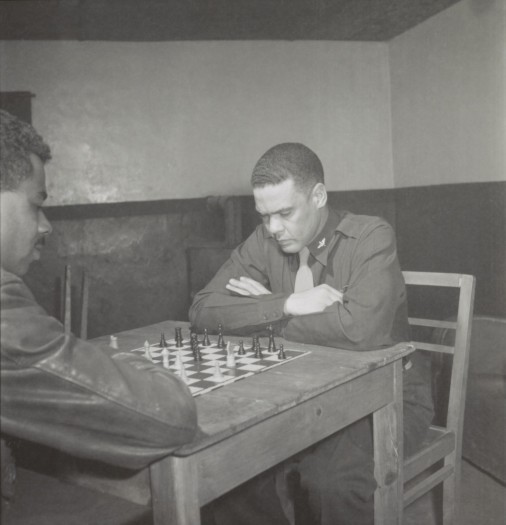
Toni Frisell
Officers in 332nd Fighter Group Playing Chess in Officers’ Club at Air Base in Southern Italy
1945
5 3⁄4 x 5 1⁄4 in.
Reproduction
Image courtesy of the Library of Congress
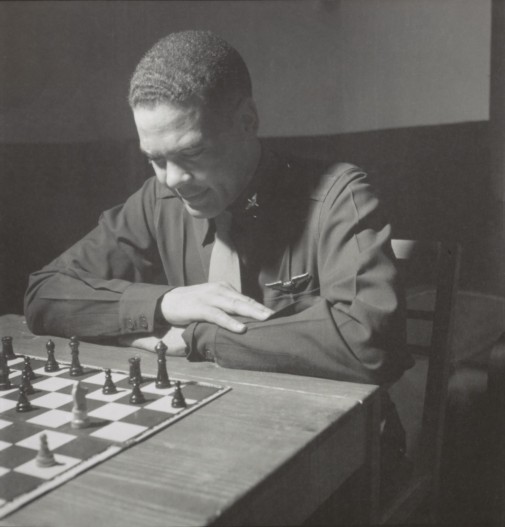
Toni Frisell
Officer in 332nd Fighter Group Playing Chess in Officers’ Club at Air Base in Southern Italy
1945
5 3⁄4 x 5 1⁄4 in.
Reproduction
Image Courtesy of the Library of Congress
A renowned fashion photographer, during World War II Toni Frissell turned her lens to war reportage. Through her volunteer work with the American Red Cross, Eighth Army Air Force, and Women’s Army Corps, Frissell captured images of military life and aid efforts. In March 1945, she photographed the 332nd Fighter Group, better known as the Tuskegee Airmen. Through her photographs of them preparing for combat and at rest, she aimed to demonstrate the excellence of African American service members during a time of segregation. Here the soldiers engage in simulated battle over the board, but in many of her other photographs, they prepare for combat while stationed in Italy.
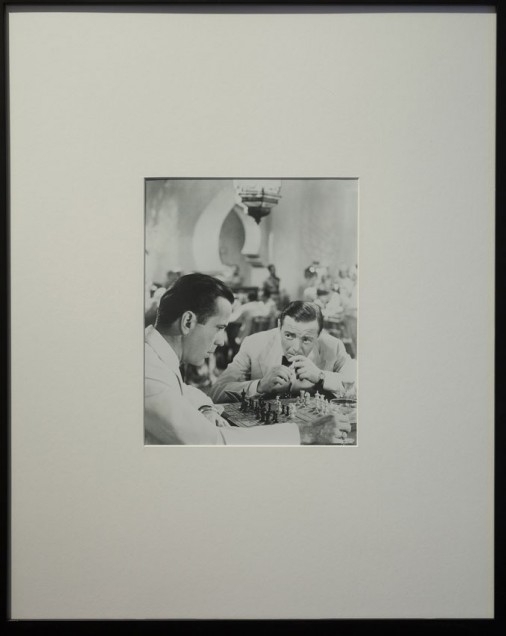
Humphrey Bogart Playing Chess—Film Still from Casablanca
1942
6 3/4 x 8 1/2 in.
Print, Photograph
Collection of the World Chess Hall of Fame
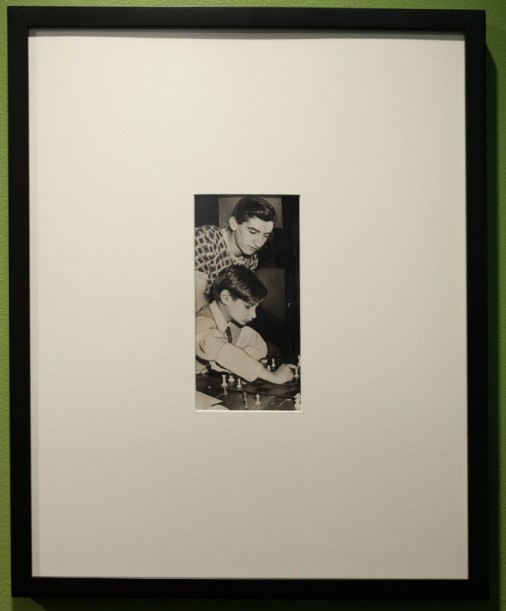
Mental Training
February 11, 1947
8 1⁄2 x 6 1⁄2 in.
Photograph
Collection of Duncan Pohl
In this press photograph, a young boy orphaned by the war concentrates on a game of chess. This image was used to illustrate a story about American efforts to aid war orphans, and the caption stated, “Mental training derived from [the] chess game will help this boy develop into [an] intelligent, useful citizen.” In 1945, President Harry S. Truman issued his Directive on Displaced Persons, which aimed to assist European refugees living in displaced persons camps by helping some immigrate to new homes in the United States. As part of these efforts, 1387 children who had lost their families during the war found new homes in the United States.
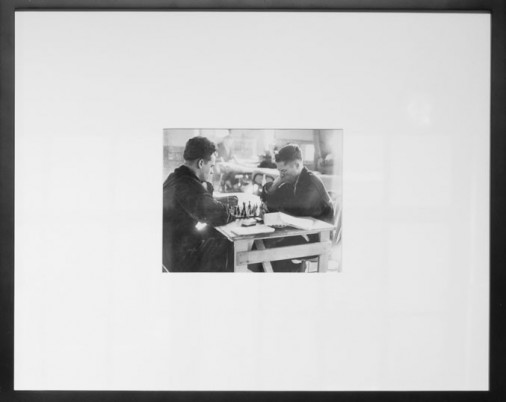
Relaxation
December 9, 1943
7 1⁄2 x 6 in.
Photograph
Collection of the World Chess Hall of Fame
While recuperating in a hospital in England, Lieutenant John Hickman of the Army Air Corps and Warrant Officer Alfred Montague ponder their next moves in a game of chess. The two were wounded in action in Europe. In the United States, the Red Cross provided chess sets at all of its hospitals as the game was well-suited for providing mental stimulation to injured service members with limited mobility.
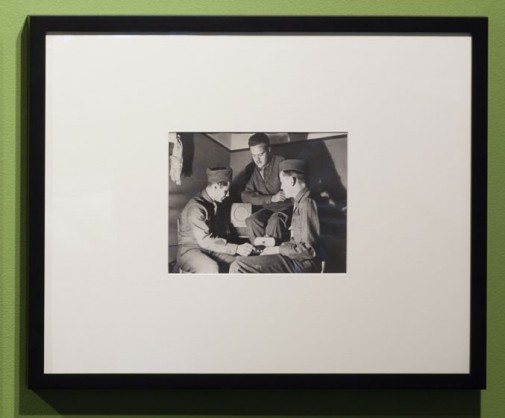
Chess With Music
February 17, 1943
8 x 6 1⁄2 in.
Photograph
Collection of the World Chess Hall of Fame
In an army camp in North Africa, Master Sergeant Gil Schaefer and Corporal Harry Soir play chess as Lieutenant Charles Carson looks on. The two play on a small travel chess set with pegged pieces while listening to music broadcast by the U.S. Army Broadcasting Service.
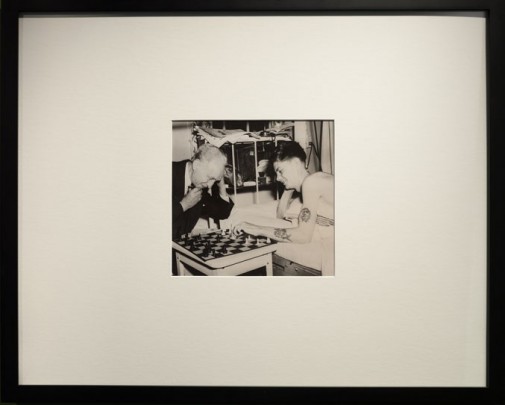
Bruno Czaikowski Playing Chess with Milford Wedeking
1951
Photograph
6 3/4 x 6 1/2 in.
Collection of the World Chess Hall of Fame
Bruno Czaikowski, a longtime fixture of the chess scene in Chicago by the 1940s, began visiting wounded veterans in the city’s Gardiner General Hospital in 1943. His volunteer work became a passion, and following the war, he continued his work with wounded veterans. In 1946, he began volunteering at Vaughan General Hospital (later Edward Hines, Jr. Veterans Affairs Hospital), and according to the article supplementing this photograph, never missed a Sunday of visiting through 1951. Here he plays chess against Milford Wedeking, a veteran with paraplegia.
Press
5/30/2018: Washington Times — During World War II, chess angels aided the wounded
10/7/2016: Mental Floss — Show & Tell: Postal Chess Set for Wounded WWII Vets
1/7/2016: On Chess: Looking back at the tournaments and exhibitions of 2015
12/30/2015: St. Louis Public Radio — On Chess: Blood drive combines history and helping
9/7/2015: The Chess Drum — Reflections of 2015 Sinquefield Cup
8/28/2015: West End Word — “Mischief Makes A Move” World Chess HOF Brings Dadaist Exhibition to Central West End
7/21/2015: HEC TV — Battle of the Boards-World Chess HOF (video)
7/6/2015: Art Daily — ‘Battle on the Board: Chess during World War II’ opens at the World Chess Hall of Fame
7/1/2015: St. Louis Public Radio — On Chess: Connection to the Greatest Generation
6/26/2015: Riverfront Times — 7 Things to Do This Week for $10 or Less
Battle on the Board Exhibition Press Release
11/19/2014: USCF — World Chess Hall of Fame Call for WW2 Artifacts
Downloads
Private Sponsor





